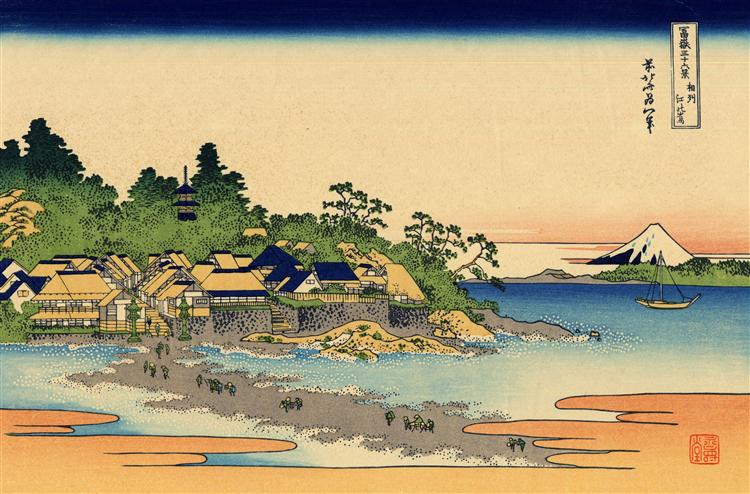Description
Katsushika Hokusai's painting "Enoshima in Sagami Province" is a prominent example of ukiyo-e, a woodblock print technique that flourished in Japan during the 17th to 19th centuries. This work, produced in the first half of the 19th century, encapsulates several elements that are characteristic of Hokusai's style, while also offering an in-depth look at the Japanese landscape and culture of his time.
At first glance, the composition is divided into three main parts that merge nature and human architecture in a harmonious atmosphere. In the foreground, small boats are seen navigating with difficulty through the gentle undulations of the waves. These boats, possibly used by fishermen, are delicately painted, highlighting Hokusai's mastery in depicting the daily life of his time. The human figures seen in these boats are tiny, almost irrelevant compared to the enormous majesty of the landscape that surrounds them. However, their inclusion emphasizes the relationship between man and nature, always present in Hokusai's work.
The Enoshima Peninsula, rising in the background, is presented in an almost ethereal treatment. Hokusai employs a combination of green and blue hues to bring to life the hills that stretch towards the sky. The use of colour is remarkable: the blue of the sea and sky contrasts with the warmer tones of the vegetation, creating a sense of freshness and calm. This vibrant and contrasting colour palette is one of the most striking features of Hokusai’s work, who is not afraid to employ bold colours to evoke a strong emotional atmosphere.
The sky, spread out with scattered clouds, suggests an impending change in the weather, a typical element in the ukiyo-e technique that represents not only the weather, but also the mood of the landscape itself. Hokusai, known for his meteorological studies, seems to be alluding to a moment of transition, where the serenity of the day prepares to give way to something more turbulent. This kind of interpretation reflects a sensitivity to nature that permeates his work and the tradition of Japanese art.
Enoshima, besides being a beautiful landscape, has a cultural and spiritual significance. The island has been associated with the cult of Benten, the goddess of art and wisdom, which adds a deeper dimension to the work. The way Hokusai presents the landscape can be interpreted as a tribute to this deity, creating a mystical atmosphere that resonates with the history of the place.
Throughout his career, Hokusai pioneered the use of perspective and the depiction of landscapes, something that can be seen not only in Enoshima in Sagami Province, but also in later works such as The Great Wave off Kanagawa. Hokusai's attention to detail and ability to capture the essence of the natural environment place him among the greatest masters of Japanese art. His ability to integrate the human figure into the landscape, however small, also establishes a continuous dialogue between humans and their environment, a recurring theme in his work.
"Enoshima in Sagami Province" is not only a visual testimony of a Japanese landscape, but becomes a symbol of the intrinsic relationship between humans and nature, where each element has its place and meaning. The work, rich in color and detail, continues to captivate viewers, offering a respite from modern life and a glimpse of the sublime beauty of the natural world that Hokusai so masterfully preserved for posterity.
KUADROS ©, a famous painting on your wall.
Hand-made oil painting reproductions, with the quality of professional artists and the distinctive seal of KUADROS ©.
Painting reproduction service with satisfaction guarantee. If you are not completely satisfied with the replica of your painting, we will refund 100% of your money.

